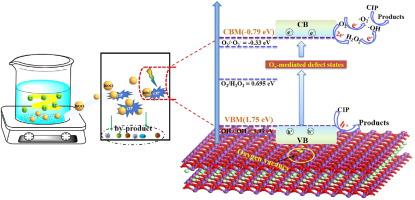Chemical Engineering Journal ( IF 15.1 ) Pub Date : 2020-10-31 , DOI: 10.1016/j.cej.2020.127573 Sha Chen , Danlian Huang , Piao Xu , Wenjing Xue , Lei Lei , Yashi Chen , Chengyun Zhou , Rui Deng , Wenjun Wang

|
Herein, a facile in-situ topological transformation where BiVO4 nanosheets (NS) with open instead of closed and inert surface are used as template and original material for the preparation of ultrathin BiOCl NS is proposed. The BiOCl NS developed in this work not only inherits the two-dimensional nanosheet structure of the BiVO4 precursor, but also exhibits improved light-harvesting ability in the meantime as a result of the retention of oxygen vacancies during the topological transformation. The defect state mediated by oxygen vacancies under the conduction band endows BiOCl a narrower forbidden band width as compared to its bulk counterpart, which extends its light absorption range from ultraviolet to visible light region. More importantly, oxygen vacancies can also act as cocatalyst to accept photogenerated electrons excited from the valence band of BiOCl, which greatly suppresses the recombination of electron-hole pairs and prolongs the carrier lifetime, thereby promoting the activation of molecular oxygen into superoxide radicals (·O2-) under visible light irradiation. As expected, the optimal BiOCl-3 NS exhibits a 2.2-fold increase in the yield of ·O2- radicals compared with bulk-BiVO4. Furthermore, a large amount of free H+ in the waste acid wastewater can be tightly adsorbed with the terminal oxygen atoms of the (001) facet of BiOCl to compensate for its dangling bonds, which inhibits the crystal growth along the c axis, leaving highly reactive (001) facets as the dominant facets. Thanks to these merits, BiOCl-3 displays the highest photocatalytic performance towards ciprofloxacin (CIP) degradation among all samples, with the corresponding degradation rate of 4.51 times higher than that of the bulk-BiVO4, and the apparent quantum efficiency of 0.411%. Moreover, the as-developed BiOCl NS has excellent stability even after five successive cycles, with no significant changes in photocatalytic activity and structure, showing its good potential in practical applications.
中文翻译:

钒酸铋拓扑转换为氯氧化铋:具有氧空位的超薄纳米片的带隙工程用于有效的分子氧活化
在此,提出了一种简便的原位拓扑转化方法,其中以开放而不是封闭和惰性表面的BiVO 4纳米片(NS)为模板,并提出了制备超薄BiOCl NS的原始材料。在这项工作中开发的BiOCl NS不仅继承了BiVO 4的二维纳米片结构前体,但同时由于拓扑转换过程中保留了氧空位,因此还表现出改善的集光能力。由传导带下的氧空位所介导的缺陷状态使BiOCl与其本体对应物相比具有更窄的禁带宽度,从而将其光吸收范围从紫外线扩展到可见光区域。更重要的是,氧空位还可以充当助催化剂,接受从BiOCl价带激发的光生电子,这大大抑制了电子-空穴对的重组并延长了载流子寿命,从而促进了分子氧活化为超氧自由基(· Ø 2 -)在可见光照射下。正如预期的那样,最佳的BiOCl-3 NS表现出的产率2.2倍的增加·O2 2 -基团与本体- BiVO相比4。此外,废酸废水中的大量游离H +可以被BiOCl(001)面的末端氧原子紧密吸附,以补偿其悬空键,从而抑制了晶体沿c轴的生长,从而高度反应性(001)面为主要面。由于这些优点,BiOCl-3在所有样品中对环丙沙星(CIP)降解显示出最高的光催化性能,相应的降解速率比本体BiVO 4高4.51倍,表观量子效率为0.411%。此外,已开发的BiOCl NS即使在连续五个循环后仍具有优异的稳定性,并且光催化活性和结构没有显着变化,显示出其在实际应用中的良好潜力。



























 京公网安备 11010802027423号
京公网安备 11010802027423号